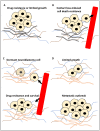Metastasis in Neuroblastoma and Its Link to Autophagy
- PMID: 36983973
- PMCID: PMC10056181
- DOI: 10.3390/life13030818
Metastasis in Neuroblastoma and Its Link to Autophagy
Abstract
Neuroblastoma is a paediatric malignancy originating from the neural crest that commonly occurs in the abdomen and adrenal gland, leading to cancer-related deaths in children. Distant metastasis can be encountered at diagnosis in greater than half of these neuroblastoma patients. Autophagy, a self-degradative process, plays a key role in stress-related responses and the survival of cells and has been studied in neuroblastoma. Accordingly, in the early stages of metastasis, autophagy may suppress cancer cell invasion and migration, while its role may be reversed in later stages, and it may facilitate metastasis by enhancing cancer cell survival. To that end, a body of literature has revealed the mechanistic link between autophagy and metastasis in neuroblastoma in multiple steps of the metastatic cascade, including cancer cell invasion and migration, anoikis resistance, cancer cell dormancy, micrometastasis, and metastatic outbreak. This review aims to take a step forward and discuss the significance of multiple molecular players and compounds that may link autophagy to metastasis and map their function to various metastatic steps in neuroblastoma.
Keywords: autophagy; metastasis; neuroblastoma; paediatric cancers.
Conflict of interest statement
The author declares no conflict of interest.
Figures








Similar articles
-
Autophagy in cancer metastasis.Oncogene. 2017 Mar 23;36(12):1619-1630. doi: 10.1038/onc.2016.333. Epub 2016 Sep 5. Oncogene. 2017. PMID: 27593926 Free PMC article. Review.
-
Pygenic Acid A (PA) Sensitizes Metastatic Breast Cancer Cells to Anoikis and Inhibits Metastasis In Vivo.Int J Mol Sci. 2020 Nov 10;21(22):8444. doi: 10.3390/ijms21228444. Int J Mol Sci. 2020. PMID: 33182770 Free PMC article.
-
CD44-high neural crest stem-like cells are associated with tumour aggressiveness and poor survival in neuroblastoma tumours.EBioMedicine. 2019 Nov;49:82-95. doi: 10.1016/j.ebiom.2019.10.041. Epub 2019 Nov 2. EBioMedicine. 2019. PMID: 31685444 Free PMC article.
-
Crosslink between p53 and metastasis: focus on epithelial-mesenchymal transition, cancer stem cell, angiogenesis, autophagy, and anoikis.Mol Biol Rep. 2021 Nov;48(11):7545-7557. doi: 10.1007/s11033-021-06706-1. Epub 2021 Sep 14. Mol Biol Rep. 2021. PMID: 34519942 Review.
-
Autophagy inhibition suppresses pulmonary metastasis of HCC in mice via impairing anoikis resistance and colonization of HCC cells.Autophagy. 2013 Dec;9(12):2056-68. doi: 10.4161/auto.26398. Epub 2013 Oct 1. Autophagy. 2013. PMID: 24157892
Cited by
-
Neuroblastoma Interaction with the Tumour Microenvironment and Its Implications for Treatment and Disease Progression.Curr Oncol. 2023 Oct 15;30(10):9116-9140. doi: 10.3390/curroncol30100659. Curr Oncol. 2023. PMID: 37887559 Free PMC article. Review.
-
Clinical characteristics and prognoses in pediatric neuroblastoma with bone or liver metastasis: data from the SEER 2010-2019.BMC Pediatr. 2024 Mar 7;24(1):162. doi: 10.1186/s12887-024-04570-z. BMC Pediatr. 2024. PMID: 38454422 Free PMC article.
-
A clinical prediction model for distant metastases of pediatric neuroblastoma: an analysis based on the SEER database.Front Pediatr. 2024 Sep 19;12:1417818. doi: 10.3389/fped.2024.1417818. eCollection 2024. Front Pediatr. 2024. PMID: 39363969 Free PMC article.
-
The link between the trans-Golgi network and tumour progression.Mol Biol Rep. 2025 Apr 28;52(1):435. doi: 10.1007/s11033-025-10548-6. Mol Biol Rep. 2025. PMID: 40293576 Free PMC article. Review.
-
SAP30, a novel autophagy regulatory gene in neuroblastoma.Mol Ther Oncol. 2024 Dec 6;33(1):200916. doi: 10.1016/j.omton.2024.200916. eCollection 2025 Mar 20. Mol Ther Oncol. 2024. PMID: 40190355 Free PMC article.
References
-
- Cohn S.L., Pearson A.D.J., London W.B., Monclair T., Ambros P.F., Brodeur G.M., Faldum A., Hero B., Iehara T., Machin D., et al. The International Neuroblastoma Risk Group (INRG) classification system: An INRG Task Force report. J. Clin. Oncol. 2009;27:289–297. doi: 10.1200/JCO.2008.16.6785. - DOI - PMC - PubMed
-
- Brodeur G.M., Pritchard J., Berthold F., Carlsen N.L., Castel V., Castelberry R.P., De Bernardi B., Evans A.E., Favrot M., Hedborg F. Revisions of the international criteria for neuroblastoma diagnosis, staging, and response to treatment. J. Clin. Oncol. 1993;11:1466–1477. doi: 10.1200/JCO.1993.11.8.1466. - DOI - PubMed
Publication types
LinkOut - more resources
Full Text Sources

